
|
Dr. Hermann Cuntz Independent Group Leader Ernst Strüngmann Institute (ESI) for Neuroscience in Cooperation with Max Planck Society Frankfurt Institute for Advanced Studies (FIAS) - affiliated as Research Fellow 3R-Center Gießen - ICAR3R - affiliated through Peter Jedlicka group Contact info: Ernst Strüngmann Institute (ESI) Deutschordenstraße 46 D-60528 Frankfurt/Main, Germany Tel. +49-(0)-69-96769-545 Email hermann.neuro (at) gmail.com |

|
|
The big picture How are neurons connected? What are the fundamental principles of wiring in the brain, i.e. what is the connection code? What are the implications for computation and function? Just as the gene map carries the rules for the structural design of any given organism, it is thought that the map of all circuits in the brain will help unravel its design principles and reveal much about its functioning. A realm of novel techniques has recently emerged allowing the dissection of neural circuits at various levels to ultimately obtain the so-called connectome describing all connections in a given brain area. However, as opposed to the genetic system in which the underlying code is well known since the pioneering work on the structure of DNA, the corresponding connection code remains a mystery. More than a hundred years ago, however, Ramón y Cajal has suggested to interpret construction plans of the brain by observing the morphology of individual neurons. We are now responding to the challenge laid down by Cajal by developing computational tools and mathematical laws to describe this link between structure and function. Morphology is key to understanding both circuits and computation since it reflects the constraints given by both. |
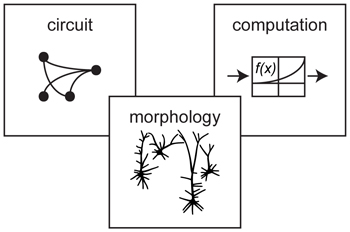
|
|
Techniques We developed a computational method which is now called morphological modelling. Assuming optimal wiring in neural circuits we adapted techniques from graph theory to derive morphologies in a reverse engineering approach (Cuntz et al 2007a; 2008; 2010; 2011; 2012; Cuntz 2012; Schneider et al 2014). The resulting synthetic morphologies, apart from withstanding rigorous physiological and anatomical analysis, pass a "Turing test" in which colleagues cannot differentiate the synthetic cells among a set of real cells. We have used these models in a multitude of projects to estimate the impact of dendrite morphology on electrophysiological properties of neurons (Cuntz et al 2013; Mazzoni et al 2015; Platschek et al 2016; Bird and Cuntz 2016; Beining et al 2017; Vormberg et al 2017, Bird and Cuntz 2019, Cuntz et al 2021). We now extend our approach to other anatomical structures e.g. neural maps (Weigand et al 2017) and cortical folding (Groden et al 2019). See here for more details about the individual projects. |
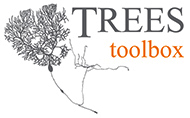 |
The TREES toolbox We are committed to sharing our code and data in the spirit of the new field of Neuroinformatics. We developed and maintain the TREES toolbox, a Matlab toolbox to generate, edit, visualize and analyze neuronal structure. |
| Outreach | |
|
our virtual reality (written by Marvin Weigand) has made it to the
Centre Pompidou
for an exhibition on neurons. Vue de l'exposition Neurones, les intelligences simulées. Centre Pompidou, Paris , Galerie 4. 26 février - 20 Avril 2020 Credit photo: Centre Pompidou/Audrey Laurans |
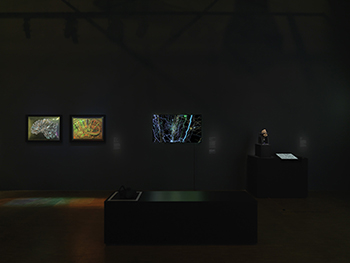 |
|
watch a
teaser to a
video installation in the
ZKM (Zentrum für Kunst und Medientechnologie Karlsruhe, engl.
Center
for Art and Media).
This movie was projected on a 2.1 x 18.4 meters panorama screen
as part of an art exhibition.
With review in the
frieze magazine, one of the leading magazines
of contemporary art and culture.
|
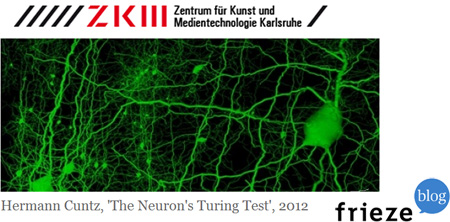 |
|
watch a 15 minute interview by Arvid Leyh on
dasgehirn.info (in German) in cooperation with Gehirn & Geist
and the Hertie Foundation.
|
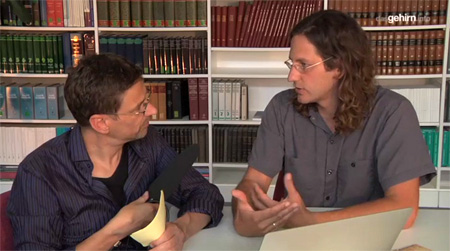 |
|
read a German popular science article written by Christiane Gelitz for
Gehirn & Geist
from the Spektrum der Wissenschaft publishing company.
|
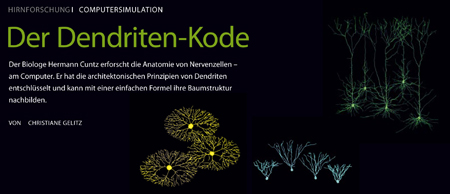 |
|
find our work in the
Wellcome Collection.
|
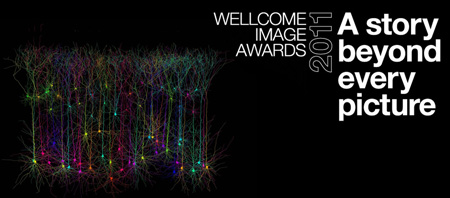 |
|
Our work was chosen to be the subject of the prototype
Science Byte
documentary program available at PBS funded by
the Alfred P. Sloan Foundation to popularise work published in PLoS.
The film was directed by Michael Schwarz and produced by
kikim media. → Enjoy! |
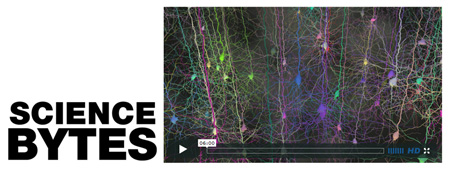 |
|
find also an article in the June 2012 issue of
WIRED UK magazine.
|
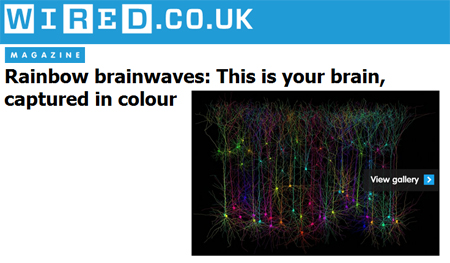
|

This work is licensed under a
Creative Commons Attribution-Noncommercial-Share Alike 3.0 License
last updated on 21 March 2024, Hermann Cuntz